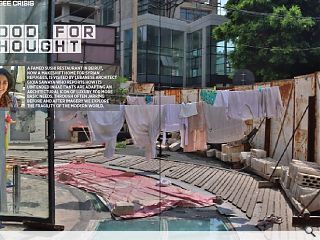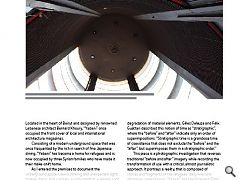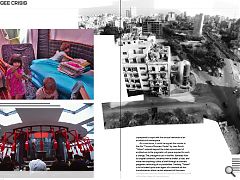Refugee Crisis: Food for Thought
18 Jan 2021
A famed sushi restaurant in Beirut, now a makeshift home for Syrian refugees, is visited by Lebanese architect Gioia Sawaya who reports how its unintended inhabitants are adapting an architectural icon of luxury for more basic needs. Through often jarring before and after imagery we explore Tthe fragility of the modern world.
Located in the heart of Beirut and designed by renowned Lebanese architect Bernard Khoury, “Yabani” once occupied the front cover of local and international architecture magazines.
Consisting of a modern underground space that was once frequented by the rich in search of fine Japanese dining, “Yabani” has become a home for refugees and is now occupied by three Syrian families who have made it their make-shift home.
As I entered the premises to document the underground space, I saw a striking and unexpected sight: broken chairs, torn curtains, a rusty bathtub, a leaking roof, and laundry everywhere. I wondered: What is it like to live in an architectural masterpiece? I began to imagine a silent dialogue between architect Khoury and the people who inhabit his creation as if they were struggling to understand each other across gulfs of time, space, and perspective.
Time is one factor by which architects study architecture. Yet, too often, architects forget to check back on their buildings to see how they are succeeding or failing. What the architect may refer to as “post-occupancy adjustments”, the inhabitants may describe as a reality check. In this sense, time does not relate only to the degradation of material elements. Gilles Deleuze and Félix Guattari described this notion of time as “stratigraphic”, where the “before” and “after” indicate only an order of superimpositions. “Stratigraphic time is a grandiose time of coexistence that does not exclude the “before” and the “after”, but superimposes them in a stratigraphic order.”
This piece is a photographic investigation that reverses traditional “before and after” imagery while recording the transformation of use with a critical, almost journalistic approach. It portrays a reality, that is composed of stories and fragments of the refugees’ daily lives and intimacies underground. “Yabani” has transgressed. From a prestigious Sushi restaurant to a make-shift home, we architects, have to learn from this drastic transformation that the space has undergone.
Hence, when thinking of recording the transformation of use of a building, “Yabani” is but an experiment that invites us to develop a new way of looking at architecture while turning away from the current trend of idealization. Fragilities are often masked by preconceived ideas of perfection and vulnerabilities are often disguised by predetermined ideas of infallibility. This gap between idealism and the day-to-day reality intersects with a world unprepared to cope with the unusual demands of an architectural masterpiece.
As a conclusion, it could be argued that similar to the film “Cocorico Monsieur Poulet” by Jean Rouch, “Yabani” extends beyond the initial commitment of architecture to the pragmatics of space required for such a change. The protagonist car in the film, liberated from its original condition, becomes here a shelter, a boat, and more than anything, a kind of shell through a constant pragmatic rethinking of its possibilities. Similarly, “Yabani” is to be looked upon as an agent of a constant ad-hoc transformation where certain elements of the space transgressed over time beyond the point of familiarity, and will perhaps keep on transgressing.
|
|





